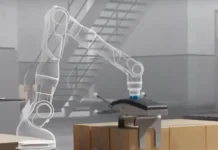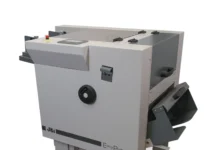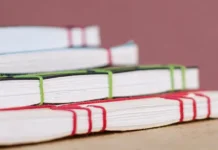by Jen Clark, The Binding Edge

Mechanical binding can be a cost-effective way to create bound documents that open flat and can offer 360-degree rotation. With the right tools, companies can have professionally punched and bound documents produced in-house. Determining if a project needs to utilize plastic coil or wire, though, starts with knowing how the finished product should look.
Since plastic coil comes in a variety of colors, it often can be matched to a theme or to a companys corporate identity. Plastic also is more durable, said David Spiel, co-owner of Spiel Associates, Long Island City, NY, “although some feel that wire is more aesthetically pleasing.”

Plastic spiral binding, single strand wire binding and double loop wire binding all are mechanical types of binding, explained Anna Massey, sales and marketing manager with Gateway Bookbinding Systems Ltd., Winnipeg, MB, Canada. Single strand wire binding typically is done with an automatic process – the metal wire being formed and wound through the punch holes to complete the book. With double loop wire binding, the pre-punched book is “hooked” onto the open wire and then the wire is closed to contain the sheets. With plastic spiral binding, the pre-formed coil is wound through the punch holes and the ends crimped to complete the process.
The popularity of one type of binding over another pertains more to the types of projects being bound, Massey said. “For example, calendars and desk calendars often still are done with double loop wire because when the item is opened, the double loop wire provides for even registration between the open sections,” she said. “Plastic spiral binding seems to have become the number one choice for student agenda books because of its safety and durability factors, as well as vast color selection.”
In the US especially, plastic coil has become the binding method of choice, Spiel added. “There are many states that bar the use of wire in school books or books for children,” he said. “Designers in the US tend to get excited over the range of colors with plastic coil.”
Added Massey: “Wire binding still often is viewed as the “strong” binding, because it is produced from metal. It’s an interesting perception because it is very easy to bend and distort wire binding – even just during transport. Plastic spiral is much more durable, but viewed – in some overseas markets – as the weaker of the two products.” Even though there has been a spike in the use of plastic coil in the European market, “double loop wire is much more popular elsewhere in the world,” Spiel said.
All types of binding have their pros and cons, Massey said. “Metal spiral and double loop wire easily are distorted and bent when shrinkwrapped or packed. Plastic spiral is more durable and will bounce back and hold its shape if or when pressure is applied.” When a straight registration of the open book is required, double loop wire is the choice, she noted. “Plastic spiral will “drop” when opened – as the opened books left side follows the angle of the coil.”
Spiel agreed, adding the left side’s “drop” is about one-half-of-a-hole lower. “That is the nature of spiral binding, but pages from left to right line up perfectly with a book bound with double loop wire. This is important with maps and ledgers,” he said.
Metal and double loop wire have limited color choices available, while plastic spiral comes in over 50 different colors, Massey said. “Plastic spiral also is a smoother product, especially when in the hands of children. Metal and double loop wire have sharp edges that can snag,” she said. “From a production standpoint, metal spiral always has been viewed as a more automated process, but plastic spiral has seen a tremendous development in this regard. There are systems putting out 25 plastic spiral bound books a minute.”
Companies that are producing documents in-house should consider outsourcing the job based on the size of the job and equipment capabilities. A project’s complexity and turnaround time also are important factors to consider. “If you only have manual equipment, you may only be able to bind 50-100 books per hour,” Spiel said. “A manual set-up will require two operators to achieve this output. If you have to pay two employees to do the work, it would be prudent to send large runs out.”
Spiel and Massey agreed that binding thick documents sometimes can be challenging. “You can bind up to about 1?” thickness with double loop wire, using 1¼” diameter wire,” Spiel said. “With plastic coil, you can bind up to 2″ in diameter and about 1¾” in thickness.” He suggests using an automatic machine to bind thick books, “such as the Sterling Coilmaster that can bind up to 50mm in diameter,” he said.
Gateway’s specialty is the PLASTIKOIL® plastic spiral, which is manufactured up to 2″ in diameter. “That can handle up to 460 sheets of a 20lb bond book,” Massey said, noting some manufacturers go even larger. Gateway also offers the PLASTIKOIL Binding Stick, which is a connecting device to join multiple plastic spiral bound books. “With the Binding Stick, there really are no limitations,” she said.
When it comes to plastic spiral binding, there are a number of options available for pitch – the distance or spacing between the loops of coil. The key is to match the pitch of the coil to the punch pattern. If a document is punched with a 4:1 pattern, then it needs a 4:1 coil. Incompatibility between pitch and punch pattern can affect productivity. “With plastic spiral binding, a wider pitch of 3:1 or 2.5:1 always is recommended for coil diameters larger than about a 30mm,” Massey said. “That is a book thickness of 1″ or more. A larger oval hole in these wider pitches also is recommended. This wider pitch and larger punch hole provides the coil with more room to find its way and thus will improve productivity as much as 45 percent.”
Double loop wire traditionally uses a 3:1 round or square hole for thinner books. A wider 2:1 pitch with a slightly larger round or square hole is used for thicker books. “Plastic spiral often was done with a 4:1 pitch round hole, but weve seen a shift over the past 10 years to a more logical .2475″ pitch 5x4mm oval hole,” Massey said. “The .2475″ pitch fits on the common 8.5×11″ and European A4 and A5 sheet sizes – without the need to pull punch pins and center.”
Partially opening a thick book while driving the coil through the punched holes helps a lot, Massey said. “The coil is driving through only half the book’s thickness at a time,” Massey noted. Gateway also offers a “reverse cut” coil in the larger diameters to help aid the insertion process. “The reverse cut lead edge smoothly funnels its way through the punch hole in comparison to the standard cut lead edge – a great advantage especially when binding thicker books.”
The Binding Edge would like to thank Anna Massey, sales and marketing manager at Gateway Bookbinding Systems Ltd., Winnipeg, MB, Canada, (www.plastikoil.com) and David Spiel, co-owner of Spiel Associates, Long Island City, NY, (www.spielassociates.com) for contributing to this article.




